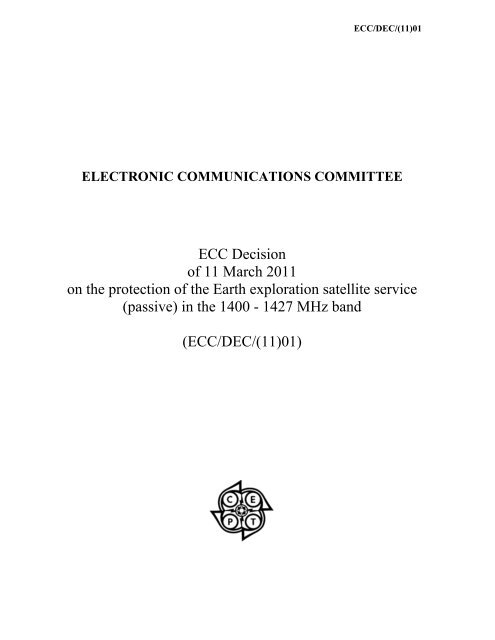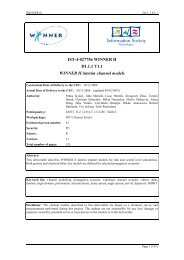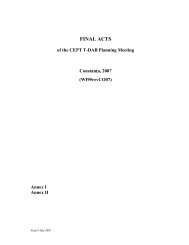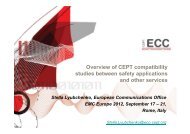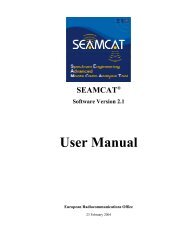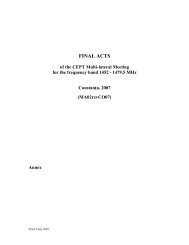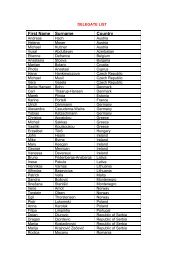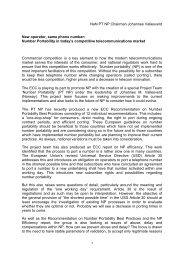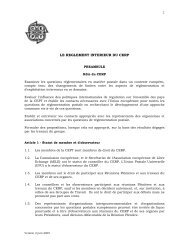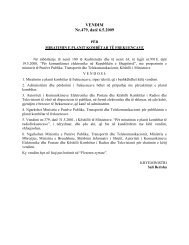ECC/DEC/(11)01 - Cept
ECC/DEC/(11)01 - Cept
ECC/DEC/(11)01 - Cept
You also want an ePaper? Increase the reach of your titles
YUMPU automatically turns print PDFs into web optimized ePapers that Google loves.
<strong>ECC</strong>/<strong>DEC</strong>/(<strong>11</strong>)<strong>01</strong><br />
ELECTRONIC COMMUNICATIONS COMMITTEE<br />
<strong>ECC</strong> Decision<br />
of <strong>11</strong> March 20<strong>11</strong><br />
on the protection of the Earth exploration satellite service<br />
(passive) in the 1400 - 1427 MHz band<br />
(<strong>ECC</strong>/<strong>DEC</strong>/(<strong>11</strong>)<strong>01</strong>)
<strong>ECC</strong>/<strong>DEC</strong>/(<strong>11</strong>)<strong>01</strong><br />
Page 2<br />
EXPLANATORY MEMORANDUM<br />
1 INTRODUCTION<br />
This <strong>ECC</strong> Decision has been developed with the aim of providing long-term coexistence conditions between active<br />
services operating below 1400 MHz or above 1427 MHz and the earth exploration satellite service (EESS) (passive)<br />
in the band 1400-1427 MHz.<br />
It provides relevant compatibility conditions to apply to active stations to ensure a relevant and long-term protection<br />
of EESS (passive) sensors.<br />
2 BACKGROUND<br />
The World Radiocommunication Conference 2007 (WRC-07) took important decisions concerning the protection of<br />
the earth exploration satellite service passive bands, in particular under its agenda item 1.20 with the adoption of<br />
Resolution 750 (WRC-07), referred by footnote 5.338A addressing the compatibility between the EESS (passive)<br />
and relevant active services in various frequency bands.<br />
Although this Resolution 750 (WRC-07) recommends unwanted emission levels in the band 1400-1427 MHz to be<br />
applied to stations of active services operating in 1350-1400 MHz and 1427-1452 MHz, the discussions during<br />
WRC-07 showed that no administration argued against ensuring protection of the EESS (passive). Administrations<br />
having advocated recommended levels mainly presented arguments in relation to the application schedule of these<br />
limits highlighting regulatory constraints in relation with current issued licenses or requiring time for development<br />
of equipment fulfilling the requirements specified at WRC-07.<br />
<strong>ECC</strong> further considered these WRC-07 results and came to the conclusion that translating the recommended levels<br />
adopted at WRC-07 into mandatory limits within an <strong>ECC</strong> Decision would provide a clear and non-ambiguous<br />
message towards reaching long term EESS (passive) bands protection. In addition, it will also give a clear sign to<br />
the international community about the recognition by Europe of the societal and economical values of these<br />
applications related to climate monitoring and natural disasters prediction.<br />
3 REQUIREMENT FOR AN <strong>ECC</strong> <strong>DEC</strong>ISION<br />
The allocation or designation of frequency bands under specified conditions in CEPT member countries is laid down<br />
by law, regulation or administrative action. <strong>ECC</strong> Decisions are required to deal with the carriage and use of<br />
equipment throughout Europe.<br />
The <strong>ECC</strong> also recognizes that a clear and non-ambiguous message toward reaching long term EESS (passive) bands<br />
protection is necessary, stressing the societal and economical values of these applications related to climate change<br />
and natural disasters prediction.<br />
The harmonisation on a European basis of the condition of use of the bands below 1400 MHz and above 1427 MHz<br />
by active services in view of ensuring long-term protection of EESS (passive) in the 1400-1427 MHz band would be<br />
in particular consistent with the Radio Spectrum Policy Group Report and Opinion on “a coordinated EU spectrum<br />
approach for scientific use of radio spectrum” and would represent a clear sign to the international community<br />
about the importance of such applications.<br />
--------------
<strong>ECC</strong>/<strong>DEC</strong>/(<strong>11</strong>)<strong>01</strong><br />
Page 3<br />
<strong>ECC</strong> Decision<br />
of <strong>11</strong> March 20<strong>11</strong><br />
on the protection of the earth exploration satellite service (passive)<br />
in the 1400-1427 MHz band<br />
(<strong>ECC</strong>/<strong>DEC</strong>/(<strong>11</strong>)<strong>01</strong>)<br />
“The European Conference of Postal and Telecommunications Administrations,<br />
considering<br />
a) that the frequency band 1400-1427 MHz is allocated to the earth exploration-satellite service<br />
(EESS) (passive), to the space research service (passive) and to the radio astronomy service,<br />
all three on a primary basis subject to RR N° 5.340;<br />
b) that the only direct way to access to soil moisture and sea surface salinity is through the use of<br />
microwave radiometers operating at frequencies near 1400 MHz;<br />
c) that EESS (passive) sensors provide worldwide measurements for the benefit of all countries,<br />
even if these sensors are not operated by their country;<br />
d) that the frequency band is used by passive sensors to study natural phenomena producing radio<br />
emissions at frequencies fixed by the laws of nature, and therefore shifting frequency to avoid<br />
or mitigate interference problems may not be possible;<br />
e) that the unwanted emissions from active services have the potential to cause unacceptable<br />
interference to EESS (passive) sensors;<br />
f) that, for technical or operational reasons, the general limits in Appendix 3 of RR may be<br />
insufficient in protecting the EESS (passive) in specific bands;<br />
g) that, in many cases, the bands adjacent or nearby to passive service bands are used and will<br />
continue to be used for various active service applications;<br />
h) that the frequency band 1350-1400 MHz is allocated to the radiolocation service, to the fixed<br />
service and to the mobile service, all three on a primary basis;<br />
i) that the frequency band 1427-1429 MHz is allocated to the space operation (E-to-s) service, to<br />
the Mobile except aeronautical service and to the fixed service, all three on a primary basis;<br />
j) that the frequency band 1429-1452 MHz is allocated to the mobile service and to the fixed<br />
service, both on a primary basis;<br />
k) that studies have concluded that appropriate compatibility criteria applicable to the active<br />
services referred to in considering h), i) and j) would reduce this interference to a level that<br />
would permit passive sensors to operate successfully, while allowing continuing operation of<br />
these active services in the adjacent bands,<br />
l) that Resolution 750 (WRC-07) urges administrations to take all reasonable steps to comply<br />
with the recommended relevant compatibility criteria applied to the active services referred to<br />
in considering h), i) and j);<br />
m) that translating these compatibility criteria into mandatory limits in CEPT would ensure future<br />
EESS (passive) operations in these bands and will also give a clear sign to the international<br />
community about the recognition by CEPT of the societal and economical values of these<br />
applications related to climate change and natural disasters prediction.
<strong>ECC</strong>/<strong>DEC</strong>/(<strong>11</strong>)<strong>01</strong><br />
Page 4<br />
<strong>DEC</strong>IDES<br />
1. that Administrations shall ensure that no active service be operated in the band 1400-1427 MHz in<br />
accordance with No. 5.340;<br />
2. that the unwanted emissions limits detailed in the Annex shall apply to stations in the active<br />
services operating in CEPT countries in the 1350-1400 MHz and 1427-1452 MHz bands brought<br />
into use after the date mentioned in Decides 4;<br />
3. that this Decision enters into force on <strong>11</strong> March 20<strong>11</strong>;<br />
4. that the preferred date for implementation of this Decision shall be 1 st January 2<strong>01</strong>2;<br />
5. that CEPT administrations shall communicate the national measures implementing this Decision to<br />
the <strong>ECC</strong> Chairman and the Office when the Decision is nationally implemented.<br />
Note:<br />
Please check the Office web site (http://www.cept.org/eco) for the up to date position on the<br />
implementation of this and other <strong>ECC</strong> decisions.
<strong>ECC</strong>/<strong>DEC</strong>/(<strong>11</strong>)<strong>01</strong><br />
Page 5<br />
ANNEX<br />
Limits of unwanted emission power into the 1400-1427 MHz band from active service stations<br />
operating in the 1350-1400 MHz and 1427-1452 MHz bands<br />
EESS (passive)<br />
band<br />
Active service<br />
band<br />
Active<br />
service<br />
Maximum level of unwanted emission<br />
power from active service stations in a<br />
specified bandwidth within the EESS<br />
(passive) band 1<br />
1400-1427 MHz<br />
1350-1400 MHz<br />
1427-1429 MHz<br />
1427-1429 MHz<br />
1429-1452 MHz<br />
radiolocation 2<br />
fixed<br />
mobile<br />
space<br />
operation<br />
(earth-tospace)<br />
mobile<br />
except<br />
aeronautical<br />
mobile<br />
fixed<br />
mobile<br />
fixed<br />
−29 dBW in the 27 MHz of the EESS<br />
(passive) band<br />
−45 dBW in the 27 MHz of the EESS<br />
(passive) band for point-to-point<br />
−60 dBW in the 27 MHz of the EESS<br />
(passive) band for mobile service stations<br />
except transportable radio-relay stations<br />
−45 dBW in the 27 MHz of the EESS<br />
(passive) band for transportable radio-relay<br />
stations<br />
−36 dBW in the 27 MHz of the EESS<br />
(passive) band<br />
−60 dBW in the 27 MHz of the EESS<br />
(passive) band for mobile service stations<br />
except transportable radio-relay stations 3<br />
−45 dBW in the 27 MHz of the EESS<br />
(passive) band for transportable radio-relay<br />
stations<br />
−45 dBW in the 27 MHz of the EESS<br />
(passive) band for point-to-point<br />
−60 dBW in the 27 MHz of the EESS<br />
(passive) band for mobile service stations<br />
except transportable radio-relay stations 3<br />
−45 dBW in the 27 MHz of the EESS<br />
(passive) band for transportable radio-relay<br />
stations<br />
−28 dBW in the 27 MHz of the EESS<br />
(passive) band for aeronautical telemetry<br />
stations 4<br />
−45 dBW in the 27 MHz of the EESS<br />
(passive) band for point-to-point<br />
1 The unwanted emission power level is to be understood here as the level measured at the antenna<br />
port.<br />
2 The mean power is to be understood here as the total power measured at the antenna port (or an<br />
equivalent thereof) in the band 1400-1427 MHz, averaged over a period of the order of 5 seconds.<br />
3 Stations of the mobile service for cellular systems, including those complying with Recommendation<br />
ITU-R M.1457 or IMT standards, are likely to meet this unwanted emission power level.<br />
4 The band 1429-1435 MHz is also allocated to the aeronautical mobile service in eight Region 1<br />
administrations on a primary basis exclusively for the purposes of aeronautical telemetry within their<br />
national territory (RR No. 5.342).


